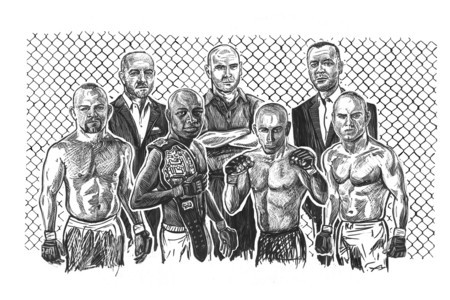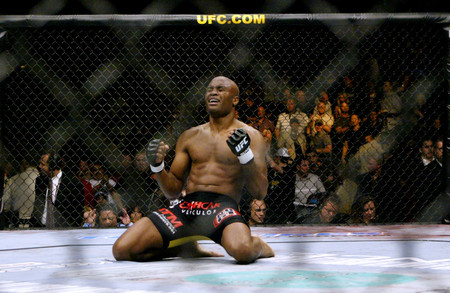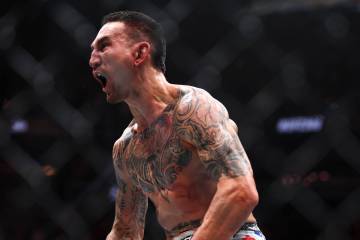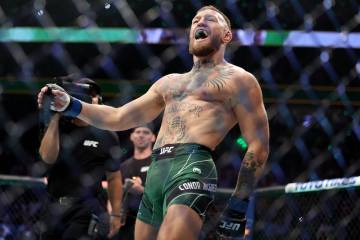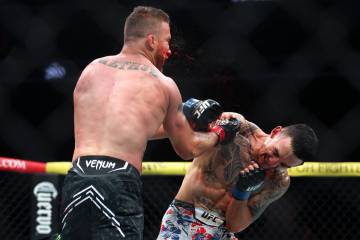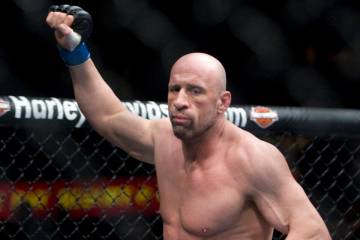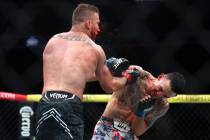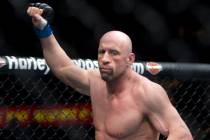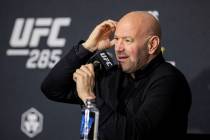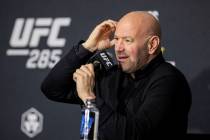Friendship, risk-taking fuel UFC’s success
The two men most often credited with making the Ultimate Fighting Championship what it is today are almost always together.
In fact, Lorenzo Fertitta and Dana White are downright inseparable.
The two have offices right down the hall from each other, are constantly texting or talking to each other on their cell phones, and are even neighbors -- for now.
"Lorenzo is moving, so now I have to think about finding a new place to live where he is," White said. "That's how sick and twisted we are. We really are that close."
White said the friendship between the two, who are each married with three children, is the main reason the pair, along with Lorenzo's brother Frank, have been able to turn a company they bought for $2 million in 2001 into a global juggernaut that Forbes estimated is worth about $1 billion last year.
"It's very rare in business that you could have three guys making decisions and have no ego problems," White said.
White said that even though Frank Fertitta doesn't have an office at the UFC's West Sahara Avenue headquarters, he's very much a part of the company.
"He's more a big-picture guy."
The brothers took a chance on purchasing the UFC when it was a struggling mixed martial arts organization that couldn't even get on pay per view, much less basic cable television.
White had been training and managing some fighters, and went to his childhood friends when he learned the UFC could be bought for a relatively small price.
Three years later, White estimates the Fertittas had sunk an additional $40 million into a company that looked like it was still going nowhere.
Things changed drastically when the UFC developed a reality show for Spike TV. The exposure to more people caused a sudden and drastic trend upward in attendance, viewership and most importantly, revenue.
"Once we got on television. There's no doubt about it," White said of when things changed for the company. " 'The Ultimate Fighter' exposed us to millions who had misconceptions about the sport, and once they were introduced to it, they fell in love with it. It's addictive."
The success of the company became very evident with the addition of key personnel in the UFC's management.
One was a very familiar face. Lorenzo Fertitta announced in early 2008 that he was leaving his executive post at Station Casinos to work full-time in a similar role at the UFC.
He was already a part of making vital decisions in the company, but the move was a clear indication that the UFC was a thriving enterprise. He made the move to help oversee the organization's plans to expand globally.
EARNING RESPECT
The other major addition was Marc Ratner as vice president of regulatory affairs.
Ratner was the respected executive director of the Nevada Athletic Commission, but he decided in 2006 to go to work for a company he once railed against.
He appeared on "Larry King Live" on a panel in the mid-1990s to speak against mixed martial arts, which at the time was a sport made up of no-holds-barred brawls.
"I sat (on that show) with Sen. (John) McCain with me on one side and (fighter) Ken Shamrock and (then-UFC owner) Bob Meyrowitz on the other saying that any sport that said they had no rules with no-holds-barred would never get in the state of Nevada."
Several years later, in late 2000, Ratner found himself on a conference call, along with several other athletic regulators and stakeholders in the sport, with the New Jersey State Athletic Control Board. That meeting led to the adoption of the Unified Rules of Mixed Martial Arts.
The rules enabled the sport, and the UFC, to become regulated in many states and eventually gain mainstream acceptance.
Ratner said despite his initial reservations, he never thought the decision by the current owners to buy the UFC was a crazy one.
"No, because I always admired (Lorenzo Fertitta's) business acumen," Ratner said. "I never thought the business would grow like this, though. I thought they could eventually make a few bucks."
White, who gets so much credit for the rapid growth of the company, passes the praise up to the Fertittas.
"It's no secret that before I started running the UFC, the biggest thing I'd done was run my gyms," White said. "I was dealing in the hundreds of dollars, not the millions of dollars. Frank and Lorenzo are obviously big business guys that think big, and I've learned a lot from them over the last 10 years."
Attempts to contact Lorenzo Fertitta went unanswered.
Long before any of the current owners were around, perhaps one man was most responsible for developing mixed martial arts as a sport.
"I remember the first time I saw UFC, I saw Royce Gracie winning the first tournament. That's the precise moment I became inspired to do what I do right now for a living," welterweight champion Georges St. Pierre said. "The fact that he was using a martial arts weapon that nobody knew at the time, which is Brazilian Jiu-Jitsu, and he was smaller than all the guys and he was able to win. That's what really inspired me."
While Gracie was the first champion, it was his brother Rorion who helped formulate the concept of mixed martial arts and the UFC. It was developed as a way to determine which martial art was the most effective.
THE FIGHTERS
The sport has evolved a great deal since that time.
Most of the top fighters in MMA today are well-rounded, having trained in most aspects of the game as opposed to being outstanding in just one phase.
St. Pierre and middleweight champion Anderson Silva are among the best. Along with lightweight titleholder B.J. Penn, St. Pierre and Silva have established themselves as the kings of their weight classes.
St. Pierre (Canada) and Silva (Brazil) also come from markets the UFC hopes to capitalize on.
Tito Ortiz was one of the first and biggest stars in the sport, but he lost twice to Chuck Liddell and once to Randy Couture. It was those fighters who really helped the UFC take the leap to the next level.
Their battles helped catapult the organization's popularity, but each fighter has contributed to the sport in other ways.
Liddell's knockout prowess and tough-guy look made him quite marketable. He was one of the first fighters to cross over into the pop-culture mainstream, appearing on television in episodes of "Punk'd" and "Entourage."
Couture has ventured into the acting world, but his greatest influence is with the fighters he trains at the mega-gym he opened in Las Vegas.
Fighters young and old call the facility home on a regular basis, but there are always new faces passing through looking to train at his elite gym.
LEADER OF THE PACK
While many mixed martial arts organizations have popped up, the UFC is the unquestioned industry leader.
Ratner says that has a lot to do with the fact that the UFC is able to control all aspects of its organization under one umbrella.
"Boxing is so scattered. I'm still as big a boxing fan as there ever was, but all the different sanctioning bodies and television being so involved, and having guys fight each other who shouldn't be fighting each other, instead of making the matches people want to see, I can see some of the shortcomings in boxing," he said.
The man responsible for making those matches is Joe Silva. The vice president of talent relations, Silva is more appropriately known as the company's matchmaker.
He doesn't do interviews, but others around the UFC don't hesitate to sing his praises.
"You can't have (the success) without the most knowledgeable matchmaker in the world," Ratner said of Silva.
It's likely, however, that Silva gets plenty of input from White.
"He looks after every aspect, whether its making ads or picking music," Ratner said of White. "Certainly, Lorenzo is too. Nothing goes out of here, whether written or filmed, without those guys touching it. They have a personal mark on it, and their vision is great."
Contact reporter Adam Hill at ahill@reviewjournal.com or 702-224-5509.
COUNTDOWN TO UFC 100



